By: Thorsten Overgaard. March 11, 2015. Updated March 22, 2015 and February 1, 2016.
What happened to all the glamour of Hollywood and the stars? I think times changed, and I find myself partly confused, partly facinated. What to make out of it all?
When I talk to people about my time at Getty Images and why I told Getty I didn't want to resign my contract with them, I usually say it was because Getty Images changed the percentages from 50/50% to 30/70% so that I would only get 30% of what my photographs generated by sale to international media.
There are two other reasons I seldom discuss.
One is that Getty Images reduced their prices of images to compete with micro stock. Micro stock is where you sell an image for a small amount like $3 or $5 to anybody who want to use it for anything. Before that images were sold based on the size they would appear in, the number of prints and how long the article with the image would be available. A single use of an image in for example TIME would be good business.
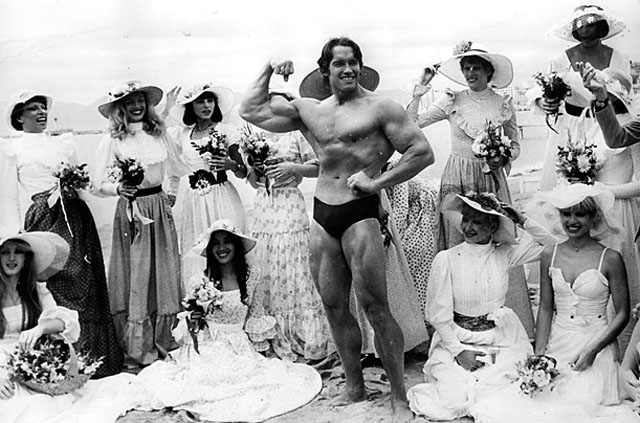
Arnold Schwarzenegger at Cannes Film festival 1977
The thinking at Getty Images seemed to be that if new websites sold pictures of cats, meeting tables and happy surfers for $3 as microstock, all images had to be that price. This meant that a unique photo of the Queen of Denmark, or a photo of Wim Wenders that I got after spending a day attending a film festival now suddenly could be bought by TIME Magazine or New York Times for 7 dollars.
I don't agree that a unique pictures for entertainment or news is the same as a micro stock photo, and logically Getty Images must have realized that they missed revenue from their picture sales now that the prices were reduced 1/20 or less. Their solution was to reduce the photographers cut to 30% and keep the 70% themselves.
Obviously, I can't spend a day at a film festival and sell images for $7 a piece, and keep only $2. It takes an extraordinary picture to sell the same image to 1,000 medias. At big events there are usually 50 or more photographers, each with their limited number of medias usign their photo.
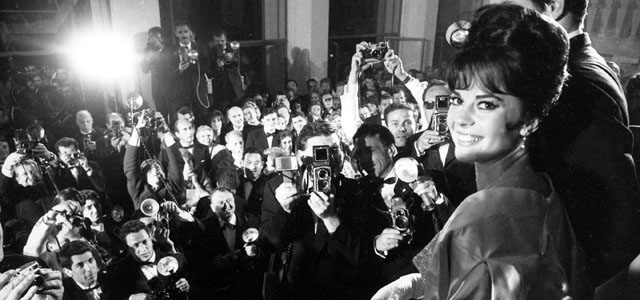
Natalie Wood at the Cannes Film Festival in 1963
It's not that micro stock is a bad idea. It's a great idea, actually. The concept before microstock was that a image usually could only be used by one company or media in one region, so you paid quite handsome for an image of a handshake or a person working in a laboratory. With microstock, photographers could suddenly offer those pictures online and hundreds or thousands could buy them for a small amount. In other words, suddenly you could sell a rather ordinary image 500 times for $3 ($1,500 in total) instead of two times $200 ($400 in total). In the early days of microstock I noticed some who made $100,000 a year on a catalog of just 100 pictures! Great for the photographers who made more money, and great for the users who got to use a $200 image for only $3. Market economy at it's best!
In the process of overlooking that fact that there is a difference between a stock photo and a unique entertainment photo, Getty forgot to make the really cool event photos. Content quality is suffering, and that is a general trend in mass media. Mass media try to look like news without any news and without any quality. It goes really fast downhill, and I don't blame Getty for trying to stay alive in that market.
We just don't match. I don't agree with the style, the lack of content and the busines model.
Glamour age
In the good old days a star was a star and was photgraphed with dignity and style. That's my ideal. I make you look great and the greater you look, the longer you will be a star and the longer my image will be valuable. The bigger a star, the more valuable the photo is.
When Hollywood was a booming place where all the buildings in Hollywood looked fancy and men dressed in suits and hats opened the doors for well dressed women, celebrity and entertainment photography was to make the subject, especially women, look particularily beautiful and attractive.
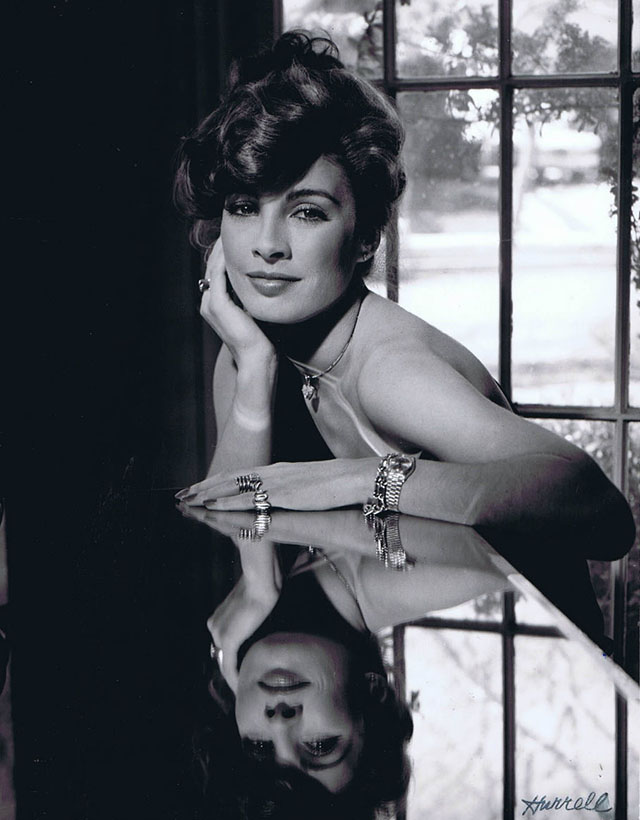 This is how any woman wants to look: Anne Archer photographed by George Hurell in 1977. Beautiful then, beautiful now.
This is how any woman wants to look: Anne Archer photographed by George Hurell in 1977. Beautiful then, beautiful now.
What happened in the period in-between the golden days of entertainment photography - that I call the Glamour Age - is that scandal gradually became the new glamour.
Let me explain.
Back in the the 30's - 50's George Hurell was the master of glamour and seem to have dedicated his life to make the world a better and more beautiful place. Dick Zimmerman was the glamour photographer of the 1980's, adding glamour, suspense and fashion to for example the Thriller cover for Michael Jackson.
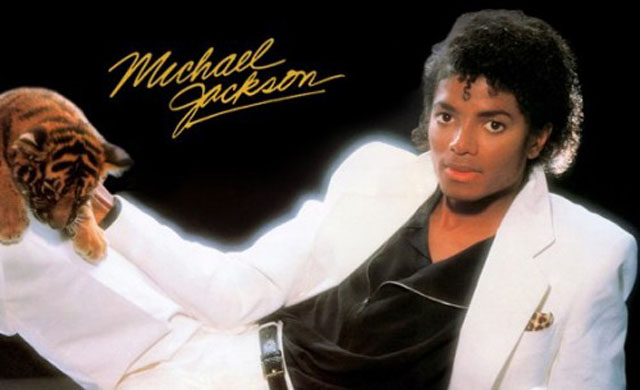
Michael Jackson by Dick Zimmerman, 1982.
Somebody got the idea that seeing the glamourous stars in track suits at the gas station filling up their Rolls Royce with gasoline was a great picture and a great story. Stars as oridnary people. It got popular with the audience and sold well. So this type of photography news spread and became how we saw the stars.
But sometimes the stars was photographed with the a person they were not supposed to be with, or pregnant when nobody knew they were pregnant, or simply trollying around in LA in yoga pants and morning hair.
The scandal was born.
It elevated the ordinary image of celebrities to another level which generated even higher interest and sold even better.
In simple terms, scandal became the new glamour.
Some of this hurt the stars or celebrities to a large degree and affected their career and income. Others "just" hurt their self-esteem and sense of privacy. But in the long run, if you take a star and make them less, the star will eventually become less valuable. So when you make a living feeding off the interest of celebrity, you cut your own income source.
Respectable newspapers today carry a gossip column where they bring these pictures and stories. The call it "gossip" or "celebrity sightings" to position it as not real news. Only problem is that it is more popular than reading about what is happening in India or Jerusalem. That's why they have the "Gossip" page.
As online media has increased and print media has decreased, gossip draws traffic and has become the way to get that traffic that allow an online media to sell ads per visitor.
In an age where we don't want to pay for a printed newspaper with no real content, you offer free online content that everybody want's to click to see: Scandals! Somebody's saggy ass, somebody's new wrinkles, somebody's lawsuits, all the trash nobody can be proud of.
It's mayhem. It's a dying culture. It's ugly.
Change gives new possibilities, even when the change is to the worse. In an age of scandal, how do celebrities and stars navigate?
The Queen of Scandal
It may be a sad thing that the glamour age is over, but if you look at things from a real-time perspective and follow the tweets, gossip pages, Instagram and all the media that today's entertainment buyers follow, you will start seeing the real art of the likes of Kanye West.
| |
 |
| |
Kanye West kissing himself went viral. Someone photoshopped Kanye into the place of his wife Kim Kardashian, and somehow it makes sense in so many ways. |
| |
|
Kanye West knows the game. He doesn't dress for glamour, but for scandal. At the Grammys, Kanye West jumped onto stage to interrupt Beck winning best album of the year. He's done it before, big scandal!
But the afterplay is his real art playing out. The intermezzo with Beck was cut out of the actual Grammy event (which is recorded hours before it is sent "live"), but not many minutes after the gossip pages anyways had footage of Kanye West causing a new scandal at the Grammys.
When you see how he twisted the incident over the weeks following, you see a master at work. Feeding the media one controversary after the other, keeping the name Kanye West in a top ranking in the consumers mind.
Nothing really happened. But it worked.
Kanye West has 191,000,000 hits on Google and 11,500,000 Twitter followers. Almost the same as Madonna, and about 1/3 of the numbers of the worlds most powerful man, Barack Obama.
Madonna showed off her butt as she exited the red carpet at the Grammys, and that was one of the most sold pictures of that event. She knows the game.
The public image as a (never failing) scandal
Amidst this detoriation of culture, Kanye West has found an interesting position as genious rebel balancing on the verge of a scandalous meltdown. You may like his music and his rebellious attitude, or you like the music and not the rest.
The way Kanye West poses is also interesting. He sort of doesn't care. That's the general attitude, but when he poses for a camera, he deliberately puts on a half-doped arrogant look so you can't tell if he is drugged and about to make a new scandal or just not paying attention. But he is. When I photographed him, I wondered exactly that question. Why doesn't he put on a bright and happy face?
But when I saw the way he uses the media, I undestood how deliberately he does it.
He has no interest in being portrayed so he looks particularly beautiful. "I am already the enemy," as he said last week, "so you can't get no worse than the villan" (The Breakfast Club radio show at Power 105.1 seen by a million people on YouTube).
Notice if you look at and listen to that interview, that even when he makes excuses, he is rolling out new controversy for media to use. Here he's talking about saying I'm sorry to Beck:
"I got his number and I was supposed to call, but I just keep forgetting it!"
"I felt good for him (Beck), 'cause think of all the good stuff that happened in the past 7-8 days. The person who won the most was Beck. Becaue if I hadn't done that (jumped on stage) his album of the year would never have been mentioned. Now it is in all the chatter".
There you go. Another two weeks of gossip blogs and tweets rolling in the deep hastagging Kanye West.
He really understands how scandal is the new glamour and that mass media like television only works with controversary.
Controversary is the new truth ... but that's another article, another day.
| |
|
|
|
|
| |
Buy the new eBook
"A Little Book on Photography"
by Thorsten von Overgaard |
|
| |
|
|
|
|
| |

Order now - Instant delivery.
More info
★
★
★
★
★
★ |
|
It's a humorous understatement to call this
new eBook by Thorsten Overgaard for
"A Little Book on Photography".
It's a grand book, a history lesson, life experience, a biography and poetry book and brilliant photo book!
All in one beautiful package of 180 pages
to fire you up and get you to love
photography ... unconditionally!
"A Little Book on Photography"
eBook for computer, Kindle and iPad.
New release March 2017.
Intro price only $47 - 180 pages.
| |
|
|
| |
Buy Now

Instant Delivery |
|
| |
|
|

|
|
| |
|
|
Loss of technical skill and quality
How does you as a photographer navigate in the age of scandal? From a photographer point of view you can't help but notice that the photographs that get the biggest circulation today seldom are the best photographs. Just the most scandalous ones. The bigger names, the better, and the more controversary, the better.
You can easily test it: Can you recall which was the most beautiful dress of the Oscars? The reason you can't is that the media all concentrate on the worst dressed.
All that work for glamour, and so little to show for it.
If you examine the photographs that has the largest circulation you will also notice that it's not the photographs that make the subject particular beautiful. Even when they are supposedly normal photos, they are really bad, technically speaking.
The art of making photos has gone, togehter with the glamour. That's what I meant about Getty not creating content anymore. They sell scandals rather than glamour.
If you want to make a living as entertainment photographer, your picture editor will likely ask you to get as many celebrities at the fashion show as possible. Walk around on first row and photograph them with a flash. The fashion show itself? Not much interest in that. It cost money to process the images into the system, and only big fashion names are interesting.
For me, that is a no-brainer, and that's why I stopped working with news media and Getty Images. Or they stopped working with me. Because they never understood why I wanted to photograph the fashion on the runway and the atmosphere backstage. They often let me do it, but it never sold any worthwhile numbers from their system. Not as much as a bad flash photo of a celebrity on the front row.
You can't spin scandal on a glamour photo. That is the harsh reality of mass media today and one of the main reasons mass media is dying. Their content doesn't contribute to anything.
The mass media is a numbers game. A photographer's goal is to make photographs. Most photographers has as a goal to show how beautiful the world can be, and preserve it. Very contradicting to mass media.
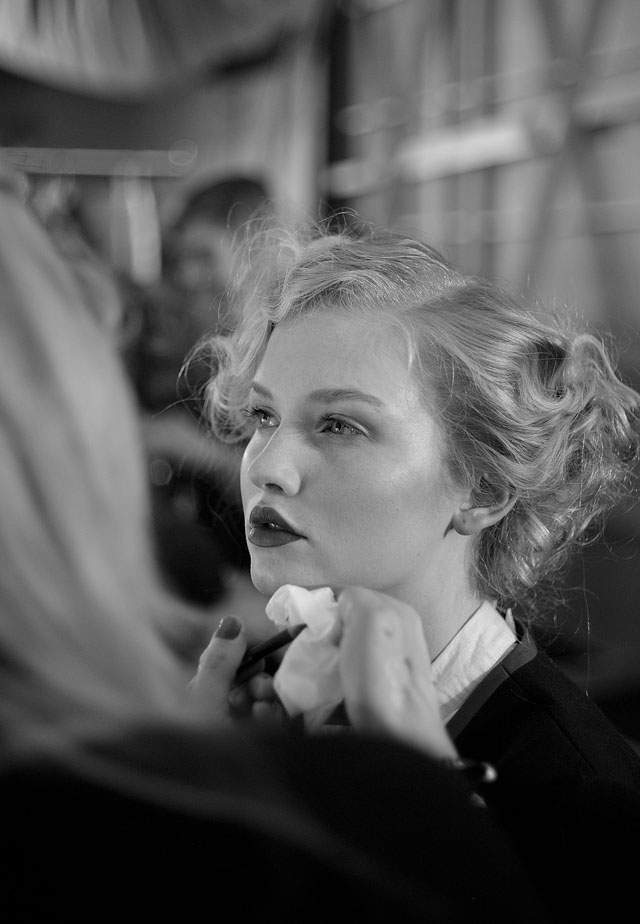
One of my best-selling exhibition photos, "Makeup" from backstage Copenhagen Fashion Week. It never made it into Getty Images, being black and white and just a pretty photo. It made me more income than a celebrity photo ever would and will continues to do so for many years.
Making glamour into scandal
The current trend of releasing pictures without photoshop of models and stars have taken a new twist, naturally. Recently normal untouched photos of Beyonce were released, and the resulting mayhem was that she had not perfect skin under harsh lights and bad photography, scandal. Cindy Crawford's photo was manipulated and photoshopped to make her look worse and older - and then released as the uncovered truth. The photographer is suing for making his photo of a naturally beautiful Cindy Crawford into a photoshopped old woman. But the photoshopped scandal version sold better than the original version. Scandal is the new glamour.

If
Idina Menzel was a Hollywood icon, the scandal probably would have been that she grabbed John Travolta's shoulder. But in the way modern media works, the story was that Travolta scandalously stroked her chin.
I saw John Travolta on stage at the Oscars, and we talked about how amazing he looks and how charming he is. And frankly, he is and was.
But what made it into the big news was the scandal of Travolta stroking his co-host Idina Menzel on the chin! A beautiful moment made into a scandal. That's how it made the news and "John Travolta stole the Oscars", meaning he was the one everybody talked about. He was the highlight of the Oscars, and this was the way they story got told. If he hadn't stroked his co-host, it would have been the hair or that he pretended not to be able to read the teleprompter. Or his shoes.
Scandal is the new glamour. You read it here first.
The artistic scandal
It's not that scandal is a brand new thing and should be avoided. In the hands of artists who can dream up new ways of doing things - like Kanye West - it be both scandalous and aesthetic.
Look through history and see how a 17 year old girl had her breakthrough hit singing "Hit Me Baby One More Time" (Britney Spears), a barely known Madonna had hers with "Like a Virgin" and an unknown Katy Perry with "I Kissed a Girl". Unlike The Sex Pistols scandalous song "God Save the Queen" who put themselves and the Queen on opposing sides of the scandal, Madonna, Britney Spears and Katy Perry all put them self in the center of the scandal - and survived.
Jeff Koons could be said to have also made himself more interesting by introducing the scandal. Himself posing with his (then porn actress and member of parliament) wife in pornographic sculptures and paintings in the 80's definitely got some attention.
Unlike the ugly scandalous photographs made to sell in great numbers to make the media and photographer rich and the subject less, the artistic scandal pushes the art and makes the artist richer and bigger.
I hope I gave you something to think about in this article today. As always, feel free to mail me comments, suggestions and ideas to thorsten@overgaard.dk
Have a blessed day.
Update:
Getty Images now introduced the category "Alternative Views" with mainly black & white photographs from a number of events. Photographs from Christopher Polk and more. Looks good!
Thorsten Overgaard, March 11, 2015
Updated March 22, 2015 and February 1, 2016.

Advertisement:


![]()
